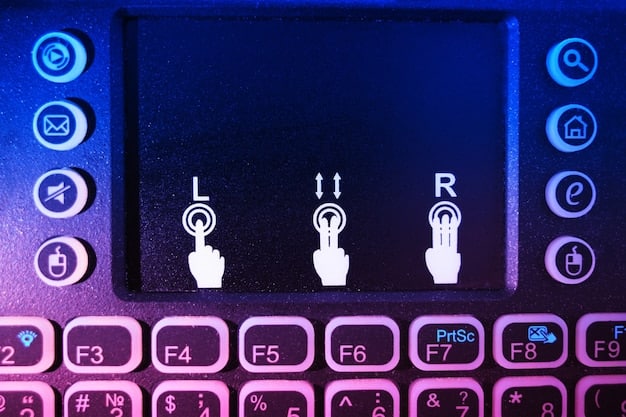Streaming Quality in Brazil: Are You Paying for Less?

Streaming quality downgrades in Brazil have become a growing concern, with many users questioning whether they are truly receiving the video resolution and overall experience they are paying for from streaming services.
Are you streaming your favorite shows and movies in Brazil, but suspect you’re not getting the quality you paid for? The issue of streaming quality downgrades in Brazil: Are You Getting What You Pay For?, is becoming increasingly prevalent, leaving many consumers frustrated and questioning the value they receive from their streaming subscriptions.
Understanding Streaming Quality: What Should You Expect?
When subscribing to a streaming service, expectations are usually high for a seamless, high-quality viewing experience. However, understanding the technical aspects of streaming quality can help you better assess whether you’re getting what you’re paying for.
Several factors determine the quality of streamed content. Let’s delve into some key components:
Resolution and Bitrate
The resolution, measured in pixels (e.g., 1080p, 4K), determines the sharpness and clarity of the image. Higher resolution means more detail and a more immersive visual experience. Bitrate, measured in Mbps (megabits per second), refers to the amount of data transferred per second. Higher bitrates generally result in better video quality with fewer compression artifacts.
Adaptive Streaming
Most streaming services use adaptive streaming, which adjusts the video quality based on your internet connection speed. This means that if your internet speed fluctuates, the streaming service may lower the resolution and bitrate to prevent buffering. While adaptive streaming ensures uninterrupted playback, it can also lead to unexpected drops in quality.

- 1080p (Full HD): Offers a good balance between image quality and data usage, suitable for most devices and screen sizes.
- 4K (Ultra HD): Provides the highest level of detail and clarity, ideal for large screens and devices that support 4K resolution.
- Bitrate Variations: Understanding the bitrate associated with each resolution is crucial. A stable, high-bitrate connection is essential for maintaining consistent quality.
Ultimately, understanding these technical aspects empowers you to make informed decisions about your streaming subscriptions and troubleshoot potential quality issues. Being aware of resolution, bitrate, and adaptive streaming helps set realistic expectations and ensures you’re getting the viewing experience you deserve.
The Brazilian Streaming Landscape: A Unique Context
Brazil’s streaming market is marked by a diverse range of providers, varying internet infrastructure, and specific consumer demands. These factors collectively impact the streaming quality experienced by users across the country.
Understanding the unique context of the Brazilian streaming landscape is crucial to addressing concerns about quality downgrades.
Internet Infrastructure Challenges
While major cities in Brazil boast relatively robust internet infrastructure, many rural and less developed areas grapple with limited bandwidth and inconsistent connectivity. This disparity affects the ability of streaming services to deliver high-quality content uniformly across the nation.
Popular Streaming Platforms in Brazil
Numerous streaming platforms compete for viewership in Brazil, each with its own approach to content delivery and quality. From global giants like Netflix and Amazon Prime Video to local players such as Globoplay, consumers have a wide array of options. However, the streaming quality can vary significantly among these platforms.

- Netflix: Known for its adaptive streaming technology, adjusting quality based on available bandwidth.
- Amazon Prime Video: Offers a range of quality settings, allowing users to customize their viewing experience.
- Globoplay: A local platform with content tailored to Brazilian audiences, but may face challenges in delivering consistent quality across different regions.
In summary, Brazil’s unique combination of internet infrastructure challenges and diverse streaming options plays a significant role in the streaming quality experienced by viewers. Addressing these factors is essential to ensuring that consumers receive the value they expect from their streaming subscriptions.
Evidence of Streaming Quality Downgrades in Brazil
Reports and anecdotal evidence suggest that streaming quality downgrades are indeed a concern for Brazilian consumers. Several factors contribute to this issue, ranging from bandwidth throttling to inconsistent content delivery.
Examining this evidence can provide a clearer picture of the challenges faced by streamers in Brazil.
Consumer Complaints and Reports
Online forums, social media, and consumer advocacy platforms are filled with complaints from Brazilian users about experiencing lower-than-expected streaming quality. Common issues include frequent buffering, pixelated video, and a lack of consistent high-definition (HD) or ultra-high-definition (UHD) playback.
ISPs and Bandwidth Throttling
Some internet service providers (ISPs) in Brazil have been accused of throttling bandwidth for streaming services, especially during peak hours. Bandwidth throttling can lead to reduced video quality and increased buffering, regardless of the consumer’s subscription tier.
ISPs often deny these accusations, citing network congestion as the primary cause of reduced streaming quality. However, the perception among consumers is that deliberate throttling is a common practice.
Several factors influence the likelihood of experiencing quality downgrades:
- Time of Day: Streaming quality tends to be lower during peak hours (e.g., evenings and weekends) when network traffic is highest.
- Location: Users in densely populated urban areas or regions with less developed internet infrastructure are more likely to experience quality issues.
- Streaming Platform: Some platforms may be more prone to quality downgrades due to their infrastructure or content delivery methods.
The evidence suggests that streaming quality downgrades are a tangible issue for many Brazilian consumers. Addressing this problem requires a collaborative effort from streaming services, ISPs, and regulatory bodies to ensure fair and consistent access to high-quality content.
Why Are Downgrades Happening? Possible Causes
Several factors can contribute to streaming quality downgrades in Brazil, and these causes are often interconnected. Understanding these issues can shed light on why some users may not be getting the quality they expect.
From network infrastructure to content delivery, the reasons behind downgrades are varied:
Network Congestion
One of the primary causes of streaming quality downgrades is network congestion. During peak hours, when many users are simultaneously accessing the internet, network infrastructure can become overloaded. This congestion can lead to reduced bandwidth availability for streaming services, resulting in lower video quality and increased buffering.
Content Delivery Network (CDN) Issues
Streaming services rely on CDNs to distribute content efficiently to users around the world. If a CDN experiences technical issues or is not properly optimized for the Brazilian market, it can result in slower content delivery and reduced streaming quality. CDNs play a vital role in ensuring smooth and reliable playback.
Several strategies can help mitigate these issues:
- Investing in Infrastructure: Upgrading network infrastructure and expanding CDN capacity can help alleviate congestion and improve content delivery.
- Optimizing Content: Compressing video files without sacrificing quality can reduce bandwidth requirements and improve streaming performance.
- Implementing Traffic Management Policies: ISPs can implement traffic management policies to prioritize streaming traffic during peak hours, ensuring a more consistent experience for users.
These causes highlight the complex interplay of factors affecting streaming quality in Brazil. Addressing them requires a multi-faceted approach involving infrastructure improvements, content optimization, and effective traffic management policies.
What Can You Do? Tips for Improving Your Streaming Experience
While streaming quality downgrades can be frustrating, there are several steps you can take to improve your streaming experience in Brazil. These tips range from optimizing your home network to adjusting your streaming settings.
By taking proactive measures, you can potentially mitigate some of the issues causing quality downgrades:
Optimize Your Home Network
Ensuring that your home network is properly configured can have a significant impact on streaming quality. Check your Wi-Fi router’s placement to ensure optimal coverage and signal strength. Consider upgrading to a newer router if your current one is outdated.
Adjust Streaming Settings
Most streaming services offer a range of video quality settings. If you’re experiencing frequent buffering or pixelation, try lowering the video quality to reduce bandwidth requirements. While this may result in a less detailed image, it can provide a more stable and uninterrupted viewing experience.
Further actions to consider include:
- Using a Wired Connection: Connecting your streaming device directly to your router via Ethernet can provide a more stable and reliable connection than Wi-Fi.
- Closing Unnecessary Applications: Closing other applications that consume bandwidth can free up resources for streaming.
- Contacting Your ISP: If you consistently experience poor streaming quality, contact your ISP to inquire about potential network issues or upgrade options.
Implementing these tips can help you take control of your streaming experience and potentially mitigate the impact of quality downgrades. By optimizing your home network and adjusting your streaming settings, you can enjoy a more reliable and enjoyable viewing experience.
The Role of Regulatory Bodies and Consumer Rights
Regulatory bodies and consumer rights organizations play a critical role in ensuring fair practices and protecting consumers from deceptive or misleading business practices in the streaming industry. In Brazil, these entities are essential for addressing concerns about streaming quality downgrades.
These organizations can hold streaming services and ISPs accountable for delivering the services promised to consumers:
ANATEL and Consumer Protection Laws
ANATEL (Agência Nacional de Telecomunicações) is the regulatory agency responsible for overseeing the telecommunications sector in Brazil. ANATEL has the authority to investigate and penalize ISPs that engage in unfair practices, such as bandwidth throttling. Consumer protection laws also provide avenues for consumers to seek redress if they are not receiving the streaming quality they are paying for.
Consumer Advocacy Groups
Several consumer advocacy groups in Brazil work to protect the rights of consumers and hold companies accountable for their actions. These groups can provide assistance to consumers who have experienced streaming quality downgrades and advocate for stronger regulations to prevent such issues.
These actions could include:
- Establishing Minimum Quality Standards: Regulatory bodies could establish minimum quality standards for streaming services, ensuring that consumers receive a consistent and acceptable viewing experience.
- Enforcing Transparency: ISPs should be required to disclose any traffic management policies that may affect streaming quality.
- Providing Redress Mechanisms: Consumers should have access to effective mechanisms for resolving disputes with streaming services and ISPs.
By leveraging the power of regulatory bodies and consumer rights organizations, Brazilian consumers can ensure that they receive the streaming quality they are paying for. These entities play a crucial role in holding companies accountable and advocating for fair and transparent practices in the streaming industry.
| Key Point | Brief Description |
|---|---|
| ⚠️ Quality Downgrades | Brazilian streamers are experiencing quality downgrades, affecting their viewing experience. |
| 🌐 Infrastructure Issues | Brazil’s internet infrastructure has challenges, causing inconsistent streaming quality across regions. |
| 💡 Tips for Improvement | Optimizing home networks and adjusting streaming settings can improve viewing. |
| ⚖️ Consumer Rights | Regulatory bodies and consumer groups protect streamers’ rights and ensure fair practices. |
FAQ
▼
Poor streaming quality can stem from network congestion, ISP throttling, or outdated home network equipment. Geographical location also plays a significant role.
▼
Optimize your home network by upgrading your router or using a wired connection. Also, adjust streaming settings to lower resolution if needed.
▼
Some users suspect ISPs are throttling bandwidth during peak hours. Monitor your connection and report issues to consumer protection agencies.
▼
ANATEL regulates the telecommunications sector and can investigate ISPs engaging in unfair practices. They enforce consumer protection laws.
▼
You have the right to receive the streaming quality you pay for. Contact consumer advocacy groups and regulatory bodies for assistance and report violations.
Conclusion
The issue of streaming quality downgrades in Brazil is a multifaceted challenge that requires attention from consumers, streaming services, ISPs, and regulatory bodies. By understanding the factors that contribute to these downgrades and taking proactive steps to improve their streaming experience, Brazilian consumers can ensure that they receive the value they expect from their streaming subscriptions.





